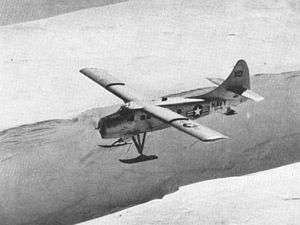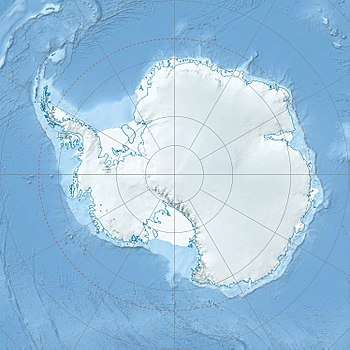Ellsworth Station
Ellsworth Scientific Station (Spanish: Estación Científica Ellsworth, or simply Estación Ellsworth or Base Ellsworth) was a permanent, all year-round originally American, then Argentine Antarctic scientific research station named after American polar explorer Lincoln Ellsworth. It was located on Gould Bay, on the Filchner Ice Shelf.
Ellsworth Station Estación Científica Ellsworth Estación Ellsworth Base Ellsworth | |
|---|---|
Antarctic base | |
| Ellsworth Scientific Station | |
 A U.S. Navy de Havilland Canada UC-1 Otter of Antarctic Development Squadron 6 (VXE-6) in flight over a large open crevasse near Ellsworth Station, Antarctica, in 1958 | |
 Ellsworth Station Location within Antarctica | |
| Coordinates: 77°39′00″S 41°02′00″W | |
| Country | |
| Province | Tierra del Fuego, Antarctica, and South Atlantic Islands Province |
| Department | Antártida Argentina |
| Region | Filchner Ice Shelf |
| Location | Gould Bay |
| Established | January 18, 1957 (1956–57 austral summer season) |
| Evacuated | December 30, 1962 |
| Named for | Lincoln Ellsworth |
| Government | |
| • Type | Directorate |
| • Body | Dirección Nacional del Antártico |
| • Operator | Instituto Antártico Argentino |
| Elevation | 42 m (138 ft) |
| Population |
|
| Time zone | UTC-3 (ART) |
| Type | All year-round (1957–1962) |
| Period | Annual |
| Status | Abandoned since 1962 over safety concerns. Remains presumed lost in Southern Ocean |
| Facilities |
|
It was shut down in 1962 over safety concerns due to it being built on increasingly unstable ice, which produced fast deterioration of its superstructures and endangered both personnel and equipment.[1]
History
Ellsworth Station was built by United States Navy Seabees under the command of Captain Finn Ronne,[2] with the support of the icebreakers USS Staten Island and USS Wyandot, captained by Francis Gambacorta.[3][4] The originally planned site for the station was Cape Adams, but when the terrain proved impractical due to huge ice cliffs, an alternate location on Gould Bay was selected,[3] on the western coast of the Weddell Sea over the Filchner Ice Shelf, and close to the Argentinean Belgrano I Base.[5]
Part of the scheduled agenda for the International Geophysical Year, Ellsworth Station was commissioned on 11 February 1957 and less than two years later, on 17 January 1959, was handed over to the Argentinean Antarctic Institute. Along with the handover, the United States government gave all the buildings, facilities, and existing food supplies while Argentina provided the logistical and administrative services necessary for the continued operation of the station.[5] It was agreed that scientists of both countries would work together at the place in technical studies and scientific research.[5]
On 31 December 1959, the Argentinean icebreaker ARA General San Martín was heading to Ellsworth Station to exchange personnel deliver and consumables when it received a SOS signal from the Norwegian–South African exploration ship Polarbjorn, which had gotten stuck in ice. The Argentineans managed to set the ship free so it could follow with its planned route along the coastline, However, the General San Martín was later unable to reach its own primary goal—located on the deepest recess of the Weddell Sea—due to unusually thick pack ice on the target area.[6]
On 6 January 1962, Frigate Captain Hermes Quijada of the Argentine Naval Aviation, leading a two-plane flight of Douglas C-47s, made a stopover at Ellsworth Base before continuing to the South Pole. He became the pilot of the first airplane that had taken off from the Americas, and then landed at the South Pole.[5][7]
Feasibility of the station came into question when structural problems caused by the unstable ice had the base half-sunken during most of the spring.[1] To protect personnel and equipment, Ellsworth base was closed and all of its staff and equipment were evacuated on 30 December 1962, during the 1962–63 antarctic summer campaign.[5] It continued to be inspected periodically by Argentinean exploration teams:[8] it was eventually covered by snow and ice. The Filchner Shelf sector where it was located as split off a giant iceberg, and then it drifted through the Southern Ocean, where the base's remains have been lost at sea.[1]
Description
The original facilities at Ellsworth Station could house over 40 people.
Scientific activities
During its operational days a number of experiments and observations were carried out at Ellsworth, involving ionospheric riometry observations; biology; human physiology; and surface and high-atmosphere meteorology, including radiation and carbon dioxide measurements.[5]
There was also active research involving glaciology at the Filchner Ice Shelf, which was explored by several expeditions launched from the station. Some of these patrols reached the West Crevice on the huge barrier, completing the Ellsworth–Belgrano triangulation.[5]
Climate
The area is a passage of weather fronts directed towards the north: although they do not precipitate, they do produce strong winds exceeding 200 km/h (120 mph) which radically lower the apparent temperature.[9]
| Climate data for Ellsworth Station | |||||||||||||
|---|---|---|---|---|---|---|---|---|---|---|---|---|---|
| Month | Jan | Feb | Mar | Apr | May | Jun | Jul | Aug | Sep | Oct | Nov | Dec | Year |
| Average high °C (°F) | −6 (22) |
−13 (9) |
−19 (−3) |
−23 (−10) |
−24 (−11) |
−28 (−19) |
−29 (−21) |
−29 (−21) |
−27 (−16) |
−19 (−2) |
−12 (11) |
−6 (22) |
−19 (−2) |
| Average low °C (°F) | −11 (12) |
−19 (−2) |
−27 (−16) |
−32 (−25) |
−32 (−26) |
−36 (−32) |
−37 (−35) |
−37 (−35) |
−34 (−30) |
−26 (−15) |
−18 (−1) |
−11 (13) |
−26 (−15) |
| Average precipitation mm (inches) | 7.6 (0.3) |
5.1 (0.2) |
7.6 (0.3) |
15 (0.6) |
5.1 (0.2) |
5.1 (0.2) |
5.1 (0.2) |
5.1 (0.2) |
7.6 (0.3) |
10 (0.4) |
13 (0.5) |
5.1 (0.2) |
86 (3.4) |
| Source: Weatherbase [10] | |||||||||||||
See also
- Argentine Antarctica
- List of Antarctic research stations
- List of Antarctic field camps
- McMurdo Station
- South Pole Station
- Byrd Station
- Palmer Station
- Siple Station
- Operation Deep Freeze
- Brockton Station
- Eights Station
- Plateau Station
- Hallett Station
- Little America V
References
- Citations
- "Campaña Antártica 1962–1963" (in Spanish). Sitio no oficial del rompehielos A.R.A. Almirante Irízar. Archived from the original on 20 February 2009.
- Griffiths 2007, p. 210.
- Mooney 1976, p. 610.
- "Antarctica Detail". geonames.usgs.gov.
- "Base Ellsworth" (in Spanish). Fundaciòn Marambio. Archived from the original on 24 March 2014.
- Symposium on Antarctic Logistics 1963.
- "Primer Vuelo Argentino al Polo Sur" (in Spanish). Fundaciòn Marambio. Archived from the original on 3 March 2011.
- "Campaña Antártica 1972–1973" (in Spanish). Sitio no oficial del rompehielos A.R.A. Almirante Irízar. Archived from the original on 24 March 2014.
- "Base Belgrano II" (in Spanish). Fundaciòn Marambio. Archived from the original on 2 June 2012.
- "Weatherbase: Historical Weather for Ellsworth, Antarctica". Weatherbase. 2011. Retrieved 24 November 2011.
- Articles
- Papers and Proceedings. Symposium on Antarctic Logistics. Boulder, CO: National Academies. 1963. p. 746. NAP:12264.
- Books
- Griffiths, Tom (2007). Slicing the Silence: Voyaging to Antarctica. Harvard University Press. p. 210. ISBN 978-0-674-02633-9.CS1 maint: ref=harv (link)
- Mooney, James L. (1976). Dictionary of American Naval Fighting Ships. Government Printing Office. ISBN 978-0-16-002030-8.CS1 maint: ref=harv (link)
.svg.png)